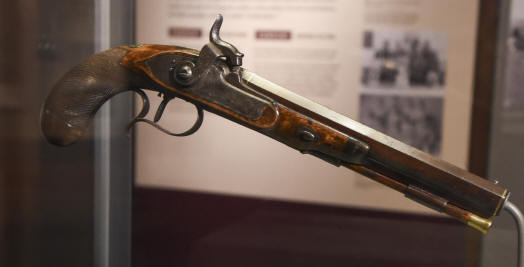Taneytown’s Gunsmith - Philip Creamer
David Buie
(8/2021) Last month's examination of the 1790 census covering Taneytown's inhabitants provided names including prominent citizens such as Adam Good, tavern keeper, and Eli Bentley, clockmaker. This month, we will highlight the life of Philip Creamer, one of the town's premier gunsmiths whose reputation came chiefly after he migrated west to Illinois and Missouri. Articles during the remainder of the year will highlight the lives of other men on the list.

Philip was born in Taneytown around 1775, a son of German immigrants according to family genealogy. He probably received his initial gunsmith training from someone already turning out weapons in the town. However, he may have gotten other experience at the Harper's Ferry Armory, which was established soon after 1800. He married Margaret McKean, a local woman, and began a family.
Not long after settling the estate of his deceased father around 1805, he relocated to the western frontier region of St. Clair County, Illinois, close to St. Louis. There he built and repaired guns for local settlers. His work's numerous account entries are found in the ledgers of the influential trading firm "Bryan and Morrison." It is strongly believed that Creamer may have played a significant role in the initial design and development of what would become known as the famous St. Louis plains rifle.
By 1809, Creamer's reputation had increased significantly, and he began making pistols for William Morrison's personal use. As a trader with powerful connections, Morrison could have ordered pistols from virtually any maker he chose. Instead, he opted to arm himself with a set crafted locally by Philip Creamer, and Morrison's powerful endorsement must have contributed to Philip's growing popularity.
Creamer's reputation rapidly spread throughout the frontier. It was soon a colloquialism that a man of dependable reputation and character was "as sure as a Creamer lock." This earned his work a special place in the hearts of people compelled to defend their reputations in the field of honor. Men about to engage in duels were known to seek out Creamer beforehand so he could personally put their pistols "in a perfect condition" for dueling.
Between 1817 and 1824, money was raised to present then Secretary of War John C. Calhoun (1782-1850) with a pistol made by Creamer. Calhoun not only accepted the gift but was so taken with its quality that he wrote the maker to inquire how he had learned to produce such magnificent weaponry. However, the proud gunsmith refused to reply, believing he was "no showman or stud-horse to be advertised."
Calhoun would serve two terms as Vice President of the United States - in 1824 under John Quincy Adams (1767-1848), and again in 1828 under Andrew Jackson (1767-1845). So perhaps it is no coincidence that "Old Hickory" would have been familiar with Creamer's work or eventually come to own a fine set of dueling pistols made by this celebrated gunsmith as well. One of the pistols is now in possession of the Hermitage Historical Museum in Davidson County, Tennessee. The Hermitage Mansion (now a museum) was the home of Andrew Jackson and his wife, Rachel (1767-1828).
The Jackson dueling pistol owned by the Hermitage is an outstanding example of Creamer's overall mastery of the art of gunsmithing. It stands out as unique even in that bygone age when all fine firearms and dueling pistols were held to the highest standards. It is also a sure bet that a man like President Andrew Jackson would demand and be satisfied with nothing less than the absolute finest. Like many finer pistols of the day, the original Creamer pistol sported inlaid bands of gold and a gold-covered maker's cartouche. Philip Creamer's hand engraving is the finest to be seen, especially for a gunsmith located on the frontier in early 19th century America. The engraving done on the Jackson pistol was undoubtedly some of Creamer's best work.
Jackson's dueling pistol is outfitted with a fine percussion lock. Creamer was one of the earliest frontier gunsmiths to specialize in making them. It's probably no coincidence that another pair of St. Louis gunsmiths, the Hawken brothers, were also known for their early use of and perfection of the percussion ignition system on both fancy pistols and their famous St. Louis plains rifles.
In 1825, Philip Creamer returned east and worked at the Harper's Ferry Armory in West Virginia. He stayed only two years and then returned to the St. Louis area, where he worked as the gunsmith for the newly opened St. Louis Superintendency for Indian Affairs until 1833. He remained in St. Louis until 1835, operating his gun shop on "Olive near Fourth." It is during this time that he likely built Jackson's dueling pistols.
It is believed that Creamer died in Green County, Illinois, around 1841.